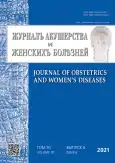The psychological portrait of pregnant women with several complications of multiple pregnancy
- Authors: Mikhaylov A.V.1,2,3,4, Zamanayeva Y.V.2
-
Affiliations:
- The Research Institute of Obstetrics, Gynecology and Reproductology named after D.O. Ott
- Maternity Hospital No. 17
- Academician I.P. Pavlov First St. Petersburg State Medical University
- North-Western State Medical University named after I.I. Mechnikov
- Issue: Vol 70, No 6 (2021)
- Pages: 49-62
- Section: Original study articles
- URL: https://journals.rcsi.science/jowd/article/view/75699
- DOI: https://doi.org/10.17816/JOWD75699
- ID: 75699
Cite item
Abstract
BACKGROUND: Multiple pregnancies are high-risk pregnancies from both an obstetric and a psychological point of view.
AIM: The aim of this study was to identify the features of prenatal experiences of women carrying multiple pregnancies and to determine the influence of several complications of multiple pregnancy on prenatal experience.
MATERIALS AND METHODS: The study involved 80 individuals aged 19 to 43 years, at a gestational age of 21 to 39 weeks, carrying twins. The patients were divided into five groups by clinical diagnosis and were asked to complete psychodiagnostic questionnaire. The answers to the questions suggested both a quantitative assessment and a qualitative description of their experiences.
RESULTS: We revealed some differences between the study groups in the frequency of manifestations of different psychological elements of the mother’s gestational dominant. Some trends were also found for differences between the groups in terms of prenatal attachment rates. An analysis of pregnant women’s descriptions of their ideas about the unborn children and communication with them showed that there were qualitative differences between the groups in the following: ideas about the characters of the unborn children, actual thoughts about them and thoughts about them after delivery, and features of the mother’s communication with them in several emotional conditions. The data obtained allowed for describing the psychological portrait of pregnant women with several complications of multiple pregnancy.
CONCLUSIONS: Depending on the type of multiple pregnancy complications, there are specific psychological experiences associated with pregnancy, future maternity and an emotional bond with the unborn children. Moreover, these experiences influence the behavior of pregnant women and their communication with other people and medical staff.
Full Text
##article.viewOnOriginalSite##About the authors
Anton V. Mikhaylov
The Research Institute of Obstetrics, Gynecology and Reproductology named after D.O. Ott; Maternity Hospital No. 17; Academician I.P. Pavlov First St. Petersburg State Medical University; North-Western State Medical University named after I.I. Mechnikov
Email: mav080960@gmail.com
ORCID iD: 0000-0002-0343-8820
SPIN-code: 7967-4999
Scopus Author ID: 18042427700
MD, Dr. Sci. (Med.), Professor
Russian Federation, Saint PetersburgYulia V. Zamanayeva
Maternity Hospital No. 17
Author for correspondence.
Email: jzamanaeva@mail.ru
Cand. Sci. (Psychol.)
Russian Federation, Saint PetersburgReferences
- Noble E. Having twins and more. N.Y.: Houghton Mifflin Company; 2003. doi: 10.1375/twin.8.4.415
- Damato EG. Maternal-fetal attachment in twin pregnancies. JOGNN Clinical Research. 2000;29(6):598−605. doi: 10.1111/j.1552-6909.2000.tb02073
- Damato EG. Predictors of prenatal attachment in mothers of twins. JOGNN Clinical Research. 2004;33(4):436−445. doi: 10.1177/0884217504266894
- Beauquier-Maccotta B, Chalouhi GE, Picquet AL, et al. Impact of monohorionicity and twin to twin transfusion syndrome on prenatal attachment, post traumatic stress disorder, anxiety and depressive sympthomes. PLoS One. 2016;11(1):e0145649. doi: 10.1371/journal.pone.01456649
- Zamanaeva YuV. Prenatal’nye poteri pri mnogoplodnoy beremennosti. Vestnik prakticheskoy psikhologii. 2020;(2):31−42. (In Russ.)
- Mikhaylov AV, Zamanaeva YuV. Psikhologiya perezhivaniya antenatal’nykh poter’. In: Plod i novorozhdennyy kak patsienty. Saint Petersburg: Petropolis; 2015. P. 696−703. (In Russ.)
- Pector EA, Smith-Levitin M. Bereavement: grief and psychological aspects of multiple birth loss. In: Multiple pregnancy: epidemiology, gestation and perinatal outcome. London; 2006. P. 862−873. doi: 10.1201/b14615-115
- Kollantai JA. Coping with the impacts of death in a multiple birth. In: Multiple pregnancy: epidemiology, gestation and perinatal outcome. London; 2006. P. 874−876. doi: 10.1201/b14615-116
- Dobryakov IV. Perinatal’naya psikhologiya. Saint Petersburg: Piter; 2010. (In Russ.)
- Zamanaeva JV. Psychodiagnostic method “Prenatal contact”: Structure and psychodiagnostic opportunities. Vestnik of Saint Petersburg University. Psychology. 2020;10(3):303–322. (In Russ.). doi: 10.21638/spbu16.2020.307
- Muller ME. Development of the prenatal attachment inventory. West J Nurs Res. 1993;15(2):199−215. doi: 10.1177/019394599301500205
- Pallant JF, Haines HM, Hildingsson I, et al. Psychometric evaluation and refinement of the prenatal attachment inventory. Journal of Reproductive and Infant Psychology. 2014;32(2):112−125. doi: 10.1080/02646838.2013.871627
- Condon JT. The assessment of antenatal emotional attachment: Development of a questionnaire instrument. Br J Med Psychol. 1993;66:167−183. doi: 10.1111/j.2044-8341.1993.tb01739.x
Supplementary files







